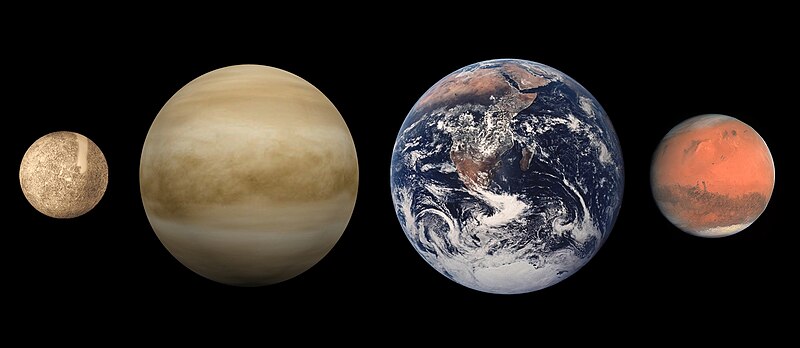檔案:Terrestrial planet size comparisons.jpg

預覽嗰尺寸:800 × 348 像素。 其他分辨率:320 × 139 像素 | 640 × 279 像素 | 1,500 × 653 像素。
原始文件 (1,500 × 653 像素,檔案大細:314 KB ,MIME類型:image/jpeg)
檔案歷史
按到日期/時間去眵吖許時間有過嗰檔案。
| 日期/時間 | 縮圖 | 尺寸 | 用戶 | 說明 | |
|---|---|---|---|---|---|
| 眼前 | 2018年12月4日 (禮拜二) 20:39 |  | 1,500 × 653(314 KB) | Allice Hunter | Correcting Mars |
| 2018年12月3日 (禮拜一) 17:21 |  | 1,500 × 653(315 KB) | Allice Hunter | updated: correcting the color of Mars. Based on image of Mars >> File:OSIRIS Mars true color.jpg. There was no distortion in size | |
| 2012年7月15日 (禮拜天) 22:37 |  | 1,500 × 653(276 KB) | Ubiquinoid | updated: correcting for apparent undersizing of Venus (from 90 to 95% (true) of Earth's diameter) - based on image of Venus w/NASA cloup map (resized) at http://cronodon.com/PlanetTech/Venus.html; centred | |
| 2012年7月15日 (禮拜天) 14:52 |  | 1,500 × 653(79 KB) | Ubiquinoid | updated: correcting for apparent undersizing of Venus (95% of Earth's diameter) - based on image of Venus w/cloup map (resized) at http://cronodon.com/PlanetTech/Venus.html | |
| 2007年12月27日 (禮拜四) 23:50 |  | 1,500 × 653(456 KB) | Crotalus horridus~commonswiki | Created identical and more compact version using the "Huffman optimized" feature of jpegcrop. Nothing else has been changed. | |
| 2006年6月14日 (禮拜三) 23:27 |  | 1,500 × 653(488 KB) | Nicke L | {{Information| |Description= The inner planets, from left to right: en:Mercury, en:Venus, en:Earth, and en:Mars Source: http://solarsystem.nasa.gov/multimedia/gallery/terr_sizes.jpg |Source= |Date= |Author=User [[:en:User:Brian0918|Br |
檔案使用
冇頁面連結到箇隻檔案。
全域文件用途
以下其他 wiki 使用了這個檔案:
- af.wikipedia.org 嗰使用狀況
- arz.wikipedia.org 嗰使用狀況
- az.wikipedia.org 嗰使用狀況
- bat-smg.wikipedia.org 嗰使用狀況
- ba.wikipedia.org 嗰使用狀況
- be-tarask.wikipedia.org 嗰使用狀況
- beta.wikiversity.org 嗰使用狀況
- be.wikipedia.org 嗰使用狀況
- bxr.wikipedia.org 嗰使用狀況
- ca.wikipedia.org 嗰使用狀況
- cv.wikipedia.org 嗰使用狀況
- da.wikipedia.org 嗰使用狀況
- da.wikisource.org 嗰使用狀況
- de.wikipedia.org 嗰使用狀況
- de.wikisource.org 嗰使用狀況
- de.wikiversity.org 嗰使用狀況
- en.wikipedia.org 嗰使用狀況
- User:Can't sleep, clown will eat me
- User:Newone
- Wikipedia:Featured picture candidates/Terrestrial planet size comparisons
- Wikipedia:Featured picture candidates/May-2006
- Talk:Dwarf planet/Archive 1
- Wikipedia:Featured picture candidates/February-2007
- Wikipedia:Featured picture candidates/Terrestrial planets
- User:Can't sleep, clown will eat me/User/appetizers
- Wikipedia:Featured picture candidates/August-2007
- Wikipedia:Featured picture candidates/Terrestrial planet size comparisons.jpg
- User:Mitternacht90/EarthandSpace
- User:HarryAlffa/Solar System synopsis
- Talk:Solar System/Archive 5
- User:Physchim62/Planetmass
檢視此檔案的更多全域使用狀況。

